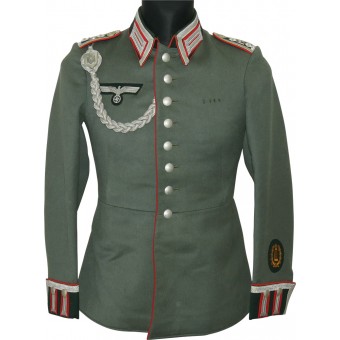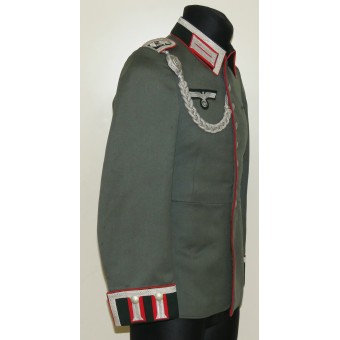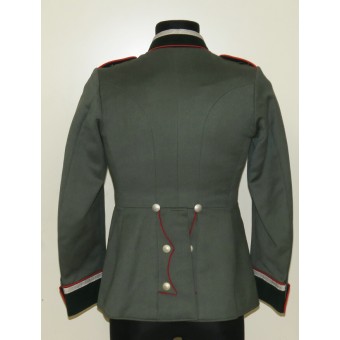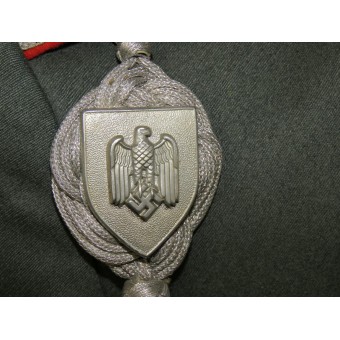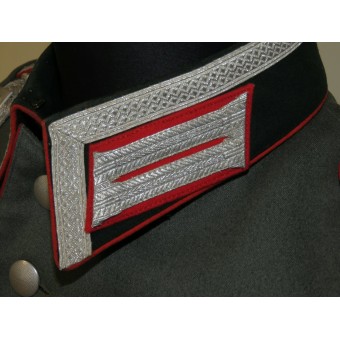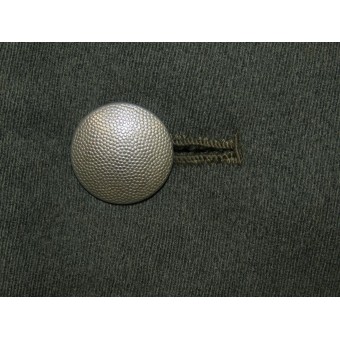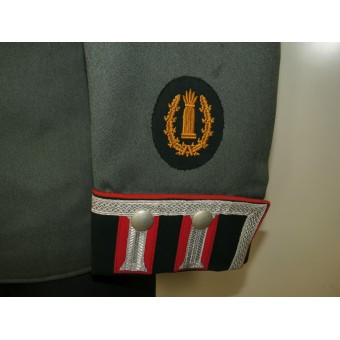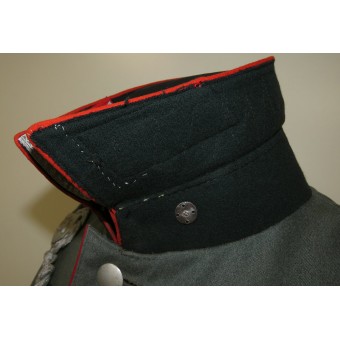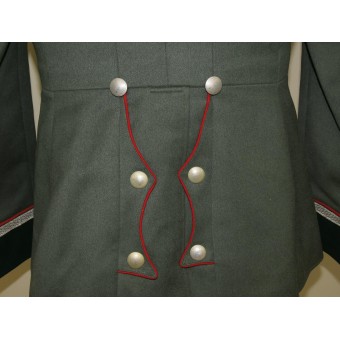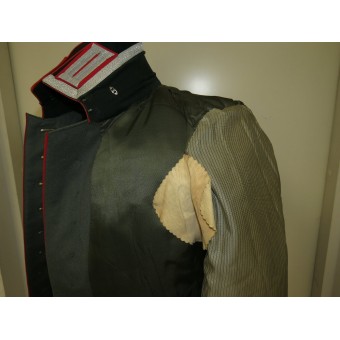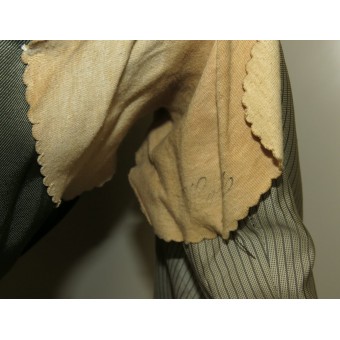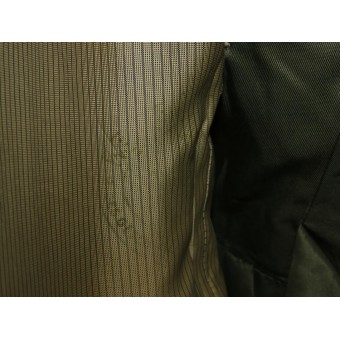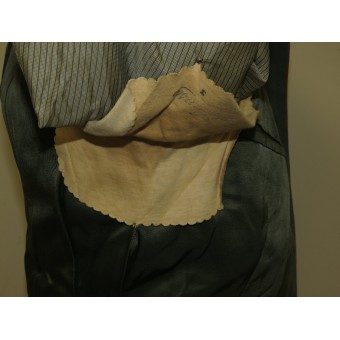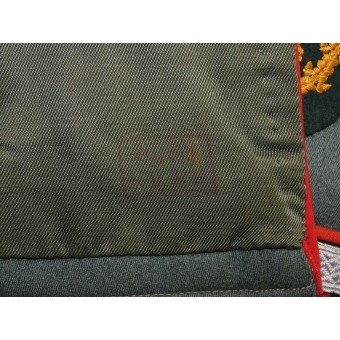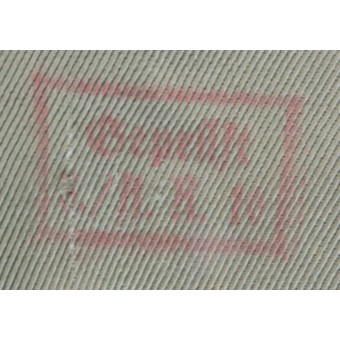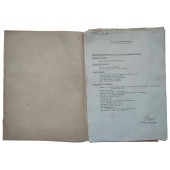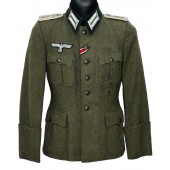Wehrmacht Heer Waffenrock Dress tunic for Oberwachtmeister der Artillerie Regiment 19, 5 Batterie
Wehrmacht Heer Waffenrock Dress tunic for Oberwachtmeister der Artillerie Regiment 19, 5 Batterie. Gun-layer (Richtkanonier) as evidenced by the sleeve patch on the left sleeve. Excellent condition with some very minor moth traces and small hole on the sleeve, the size of which is not larger than the match head. The tunic is complete with its original Wehrmacht shooting cord of the 1st type, 1st class. The tunic with all originally applied buttons and insignia. Size is small, approximately 46-48 European, with a chest size not more than 90 cm. The uniform has depot markings - Geprüft 5 / A.R 19, on both ends on the lining.
History of Art Regiment 19 (Google translation):
The Hanover Artillery Regiment was established on October 1, 1934 in Hanover, in what was then Military District VI. The regiment was formed into four departments in the course of the increase in the army by the division of the 6th (Prussian) artillery regiment. The first division was created by renaming the III. Department of the 6th (Preuss.) Artillery Regiment and was stationed in Hanover. The second division was created by levies from the 6th (Prussian) artillery regiment and was stationed in Hildesheim, then also military district VI. The III. Department was also created by levies from the 6th (Preuss.) Artillery Regiment and was stationed in Celle, then also military district VI. The fourth division was also created by levies from the 6th (Prussian) Artillery Regiment and was stationed in Braunschweig, then also military district VI. On October 15, 1935, the regiment was renamed Artillery Regiment 19. The 4th division was renamed 1st division from Artillery Regiment 55. The regiment was now under the 19th Infantry Division. On October 6, 1936, the 1st division of the regiment was renamed the 1st division of the 34th Artillery Regiment. At the same time, a new I. Department was set up from donations from Artillery Regiment 1 and Artillery Regiment 6 and stationed again in Hanover. This autumn it was also decided that the 2nd department should not be stationed in Hildesheim forever. In the fall of 1938, the 2nd department was also stationed in Hanover. In autumn 1938 there were 10th, 11th and 12th supplementary batteries in the regiment, which were used in the mobilization to form the 267 Artillery Regiment. When mobilized, the 1st division of Artillery Regiment 55 was placed under the regiment as a heavy division. On January 29, 1940 the staff of III. Department and the 2nd battery for deployment from the 295th Artillery Regiment of the 295th Infantry Division handed over and then replaced again. On May 9, 1940, the regiment was alerted and moved to the staging area. The 1st division in the western campaign: The 1st department (without 3rd battery) made itself available at Bökel in the Krefeld area on May 9, 1940 and reached the staging area in the Elmpter Wald early on May 10, 1940. On May 10, 1940 the department moved via Maasniel - Notenboom to Gebroek and moved into a bivouac here. On May 11, 1940, the department was set over the Meuse and then moved into a rest area near Thorn. On May 12, 1940 the Maastricht Canal was set and on May 13 to Pankenhof. Firing positions were moved to the east and southeast of Beeringen and the translation of Infantry Regiment 59 via the Albert Canal was supported. On May 15, 1940, the department remained quiet. Around noon the march via Monteau to St. Georges. Here the department received orders to operate in the Linden area, but this did not take place. On May 17, 1940, the division supported the attack by the 19th Infantry Division against the Dyls position, which also included English troops. At 11:00 a.m. the department crossed the canal and then marched via Steen - Ockernzeln - Peuthy - Vilvoorde to the Villebroeck Canal. The departmental batteries were deployed to fire positions east of Vilvoorde and were fighting light enemy field positions. Am18. In May 1940 the enemy had cleared the west bank of the canal. The department marched via Grimberghen - Meysse to Assche. Here she fended off an enemy tank attack and then moved on to Lsschene, where she formed a defense bar for the night. On May 19, 1940, the persecution of the enemy was continued and the dendre was crossed at 8:00 p.m. At Nukerke, new firing positions were moved because English troops had dug in here. However, the attack on the Scheldt that was set in motion did not succeed. Only a small bridgehead could be formed. On May 21, 1940, the department was moved to the room 2 km west of Schaffendaele and moved into firing positions here. Towards evening, the enemy’s own firing positions were caught by malfunctioning fire, which led to losses. The attack on the Scheldt was repeated on May 22, 1940. From 3.30 p.m. the preparation fire department fired. Their own attack began at 5:00 p.m., and the infantry was able to overcome the Scheldt. On May 23, 1940, the department crossed a 16-ton pioneer bridge across the Scheldt and moved into firing positions west of Derlyck. From here, the department fought positions on the western edge of the Riviere. On May 24, 1940 new fire positions were moved to Snepoek. The division supported Infantry Regiment 73 in crossing the Lys. On May 25, 1940, the department took up positions in the Stockery area. The 19th Infantry Division had been ordered to defend the west flank of the XXth Corps received. On May 26, 1940, the chief of the second battery, Lieutenant Hasse, and officer candidate Sergeant Pink fell in Isaghem while exploring a Bunker position. The first battery shot at enemy positions northwest of Ouckene at around 6:00 p.m. and supported the attack by the 59th Infantry Regiment. On May 28, 1940, after the capitulation of Belgium, the 19th Infantry Division resumed its advance and the division marched over Roulers - Sleyhaege - Chaep - Baillie to Veldhoek. The advance continued on May 29 and the department reached the Yser, whose banks were occupied by English units. On May 30, 1940, the German attack on British positions began, with the department supporting the attack. Subsequently, she remained in her positions until June 2, 1940, because there were not enough translation options. On June 3, 1940, the department marched via Zonnebeke - Becelaere - Linselles - to the southern edge of Roubaix. On June 4, 1940, the advance continued to Pont a Hareo, where the department in the castle underwent. Fontaineles was reached on June 7, 1940. Here the 3rd battery returned to the department that had previously been commanded to the company leadership school on the Wahn and Sennelager training areas. On the evening of June 8, 1940, the department marched on to Puisieux, Bayonvillers on the Somme on June 9, 1940, Beaufort en Santerre on June 10, 1940 and Montiers on June 11, 1940. Here the department was given a day's rest before moving north to the Compiegne Forest on June 13, 1940. Here the batteries were supposed to support the Infantry Regiment 73 in cleaning up the forest, which was no longer necessary due to the low enemy strength, so that the department moved to Gilocourt until evening. The division reached Eve on June 14, 1940 and Bobigny on June 15, 1940. The department was designated to take part in the parade through Paris on June 16, 1940. After the parade, she moved to Montlery. On June 17, 1940 they marched to Ablis, on June 18, 1940 to La folie Herbeau, on June 19, 1940 to Ozoir le breuil and on June 20, 1940 to Villetrun. The department reached Sempes until June 23, where it was given three days of rest. On June 27, 1940, the department moved into: 1st battery in Renoue, 2nd battery in La Chaussee and 3rd battery in Renoue. The staff was in La Bennetiere. Here the western campaign for the department ended. On November 1, 1940, the regiment was motorized and then referred to as the Artillery Regiment (motorized) 19. The III. Division given as 1st division to Artillery Regiment 92. The heavy artillery division 446 became the new III. Department. The subordinate 1st division of the 55th Artillery Regiment was given up as the 2nd division of the 117th Artillery Regiment of the 111th Infantry Division. The regiment was now placed under the 19th Panzer Division. On April 29, 1942, the observation department (Pz) 339 was assumed to be an observation battery (Pz) 19. On July 13, 1942, the regiment was renamed Panzer Artillery Regiment 19. The artillery replacement department 19 was initially responsible for the replacement of the regiment. From November 21, 1940, the artillery replacement department 13 took over this task.
Wehrmacht Heer Waffenrock Dress tunic for Oberwachtmeister der Artillerie Regiment 19, 5 Batterie. Gun-layer (Richtkanonier) as evidenced by the sleeve patch on the left sleeve. Excellent condition with some very minor moth traces and small hole on the sleeve, the size of which is not larger than the match head. The tunic is complete with its original Wehrmacht shooting cord of the 1st type, 1st class. The tunic with all originally applied buttons and insignia. Size is small, approximately 46-48 European, with a chest size not more than 90 cm. The uniform has depot markings - Geprüft 5 / A.R 19, on both ends on the lining.
History of Art Regiment 19 (Google translation):
The Hanover Artillery Regiment was established on October 1, 1934 in Hanover, in what was then Military District VI. The regiment was formed into four departments in the course of the increase in the army by the division of the 6th (Prussian) artillery regiment. The first division was created by renaming the III. Department of the 6th (Preuss.) Artillery Regiment and was stationed in Hanover. The second division was created by levies from the 6th (Prussian) artillery regiment and was stationed in Hildesheim, then also military district VI. The III. Department was also created by levies from the 6th (Preuss.) Artillery Regiment and was stationed in Celle, then also military district VI. The fourth division was also created by levies from the 6th (Prussian) Artillery Regiment and was stationed in Braunschweig, then also military district VI. On October 15, 1935, the regiment was renamed Artillery Regiment 19. The 4th division was renamed 1st division from Artillery Regiment 55. The regiment was now under the 19th Infantry Division. On October 6, 1936, the 1st division of the regiment was renamed the 1st division of the 34th Artillery Regiment. At the same time, a new I. Department was set up from donations from Artillery Regiment 1 and Artillery Regiment 6 and stationed again in Hanover. This autumn it was also decided that the 2nd department should not be stationed in Hildesheim forever. In the fall of 1938, the 2nd department was also stationed in Hanover. In autumn 1938 there were 10th, 11th and 12th supplementary batteries in the regiment, which were used in the mobilization to form the 267 Artillery Regiment. When mobilized, the 1st division of Artillery Regiment 55 was placed under the regiment as a heavy division. On January 29, 1940 the staff of III. Department and the 2nd battery for deployment from the 295th Artillery Regiment of the 295th Infantry Division handed over and then replaced again. On May 9, 1940, the regiment was alerted and moved to the staging area. The 1st division in the western campaign: The 1st department (without 3rd battery) made itself available at Bökel in the Krefeld area on May 9, 1940 and reached the staging area in the Elmpter Wald early on May 10, 1940. On May 10, 1940 the department moved via Maasniel - Notenboom to Gebroek and moved into a bivouac here. On May 11, 1940, the department was set over the Meuse and then moved into a rest area near Thorn. On May 12, 1940 the Maastricht Canal was set and on May 13 to Pankenhof. Firing positions were moved to the east and southeast of Beeringen and the translation of Infantry Regiment 59 via the Albert Canal was supported. On May 15, 1940, the department remained quiet. Around noon the march via Monteau to St. Georges. Here the department received orders to operate in the Linden area, but this did not take place. On May 17, 1940, the division supported the attack by the 19th Infantry Division against the Dyls position, which also included English troops. At 11:00 a.m. the department crossed the canal and then marched via Steen - Ockernzeln - Peuthy - Vilvoorde to the Villebroeck Canal. The departmental batteries were deployed to fire positions east of Vilvoorde and were fighting light enemy field positions. Am18. In May 1940 the enemy had cleared the west bank of the canal. The department marched via Grimberghen - Meysse to Assche. Here she fended off an enemy tank attack and then moved on to Lsschene, where she formed a defense bar for the night. On May 19, 1940, the persecution of the enemy was continued and the dendre was crossed at 8:00 p.m. At Nukerke, new firing positions were moved because English troops had dug in here. However, the attack on the Scheldt that was set in motion did not succeed. Only a small bridgehead could be formed. On May 21, 1940, the department was moved to the room 2 km west of Schaffendaele and moved into firing positions here. Towards evening, the enemy’s own firing positions were caught by malfunctioning fire, which led to losses. The attack on the Scheldt was repeated on May 22, 1940. From 3.30 p.m. the preparation fire department fired. Their own attack began at 5:00 p.m., and the infantry was able to overcome the Scheldt. On May 23, 1940, the department crossed a 16-ton pioneer bridge across the Scheldt and moved into firing positions west of Derlyck. From here, the department fought positions on the western edge of the Riviere. On May 24, 1940 new fire positions were moved to Snepoek. The division supported Infantry Regiment 73 in crossing the Lys. On May 25, 1940, the department took up positions in the Stockery area. The 19th Infantry Division had been ordered to defend the west flank of the XXth Corps received. On May 26, 1940, the chief of the second battery, Lieutenant Hasse, and officer candidate Sergeant Pink fell in Isaghem while exploring a Bunker position. The first battery shot at enemy positions northwest of Ouckene at around 6:00 p.m. and supported the attack by the 59th Infantry Regiment. On May 28, 1940, after the capitulation of Belgium, the 19th Infantry Division resumed its advance and the division marched over Roulers - Sleyhaege - Chaep - Baillie to Veldhoek. The advance continued on May 29 and the department reached the Yser, whose banks were occupied by English units. On May 30, 1940, the German attack on British positions began, with the department supporting the attack. Subsequently, she remained in her positions until June 2, 1940, because there were not enough translation options. On June 3, 1940, the department marched via Zonnebeke - Becelaere - Linselles - to the southern edge of Roubaix. On June 4, 1940, the advance continued to Pont a Hareo, where the department in the castle underwent. Fontaineles was reached on June 7, 1940. Here the 3rd battery returned to the department that had previously been commanded to the company leadership school on the Wahn and Sennelager training areas. On the evening of June 8, 1940, the department marched on to Puisieux, Bayonvillers on the Somme on June 9, 1940, Beaufort en Santerre on June 10, 1940 and Montiers on June 11, 1940. Here the department was given a day's rest before moving north to the Compiegne Forest on June 13, 1940. Here the batteries were supposed to support the Infantry Regiment 73 in cleaning up the forest, which was no longer necessary due to the low enemy strength, so that the department moved to Gilocourt until evening. The division reached Eve on June 14, 1940 and Bobigny on June 15, 1940. The department was designated to take part in the parade through Paris on June 16, 1940. After the parade, she moved to Montlery. On June 17, 1940 they marched to Ablis, on June 18, 1940 to La folie Herbeau, on June 19, 1940 to Ozoir le breuil and on June 20, 1940 to Villetrun. The department reached Sempes until June 23, where it was given three days of rest. On June 27, 1940, the department moved into: 1st battery in Renoue, 2nd battery in La Chaussee and 3rd battery in Renoue. The staff was in La Bennetiere. Here the western campaign for the department ended. On November 1, 1940, the regiment was motorized and then referred to as the Artillery Regiment (motorized) 19. The III. Division given as 1st division to Artillery Regiment 92. The heavy artillery division 446 became the new III. Department. The subordinate 1st division of the 55th Artillery Regiment was given up as the 2nd division of the 117th Artillery Regiment of the 111th Infantry Division. The regiment was now placed under the 19th Panzer Division. On April 29, 1942, the observation department (Pz) 339 was assumed to be an observation battery (Pz) 19. On July 13, 1942, the regiment was renamed Panzer Artillery Regiment 19. The artillery replacement department 19 was initially responsible for the replacement of the regiment. From November 21, 1940, the artillery replacement department 13 took over this task.


